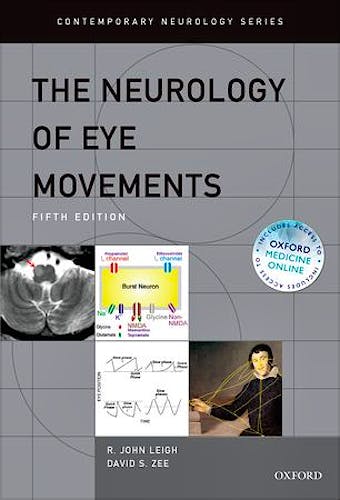

No hay productos en el carrito



The Neurology of Eye Movements
Leigh, J. — Zee, D.
5ª Edición Agosto 2015
Inglés
Tapa dura
1136 pags
2993 gr
18 x 26 x 6 cm
ISBN 9780199969289
Editorial OXFORD
LIBRO IMPRESO
-5%
448,65 €426,22 €IVA incluido
431,39 €409,83 €IVA no incluido
Recíbelo en un plazo de
2 - 3 semanas
About this Book
- New enhanced edition includes online access to the text, plus 200 videos via Oxford Medicine Online
- Provides updated research methods and results conducted regarding patients with abnormal eye movements due to a range of disorders
- Integrates a modern synthesis of the anatomy of the eye, physiological, and pharmacological substrate for eye movements, and the synthesis to the clinical and laboratory evaluation of patients with abnormal eye movements
- Presents clinical and laboratory evaluation of patients with abnormal eye movements
This new edition of "Leigh and Zee's Neurology of Eye Movements"
is available as an enhanced edition for the first time. Your purchase of the
print version includes access to the online version via Oxford Medicine Online.
By activating your unique access code, you can discover more than 200 videos,
view and enlarge nearly 250 high resolution images, and annotate the work for
future personal reference.
The Neurology of Eye Movements, edition 5 has two interrelated parts. The first
comprises a modern synthesis of the anatomical, physiological, and pharmacological
substrate for eye movements, including current views on the reflexive and voluntary
control of gaze.
This synthesis is based on electrophysiological and inactivation studies in
macaque, and behavioural studies in humans that incorporate functional imaging
and transcranial magnetic stimulation (TMS) in normals, and clinicopathological
studies in patients with neurological, visual, or vestibular disorders. Sophisticated
experimental paradigms have been applied to both species to explore aspects
of cognition, memory, volition, and reward. This large body of research has
demonstrated the power of eye movements as experimental tools. The second part
of the book applies this synthesis to the clinical and laboratory evaluation
of patients with abnormal eye movements due to a broad range of disorders -
from muscular dystrophy, and genetic disorders, to dementia, including visual
and vestibular conditions. By placing links to figures, tables, boxes, and videos,
a synthesis of basic research and clinical findings is provided, that may shed
new light on disease processes and provide insights on normal brain function.
Readership: Neurologists, ophthalmologists, otolaryngologists,
optometrists, neuroscientists, biomedical engineers, psychologists, computation
biologists
Table of Contents
Foreword
Chapter 1: A Survey of Eye Movements: Characteristics and Teleology
Chapter 2: The Ocular Motor Periphery
Chapter 3: The Vestibular-Optokinetic System
Chapter 4: The Saccadic System
Chapter 5: Smooth Visual Tracking and Fixation
Chapter 6: Gaze Holding and The Neural Integrator
Chapter 7: The Neural Basis for Conjugate Eye Movements
Chapter 8: Eye-Head Movements
Chapter 9: Vergence Eye Movements
Chapter 10: Diagnosis of Peripheral Ocular Motor Palsies And Strabismus
Chapter 11: Diagnosis of Nystagmus and Saccadic Intrusions
Chapter 12: Diagnosis and Management of Vestibular Disorders
Chapter 13: Disorders of Ocular Motility Due To Disease of the Brainstem, Cerebellum
and Diencephalon
Chapter 14: Disorders of Ocular Motility With Disease Affecting The Basal Ganglia,
Cerebral Cortex, And In Systemic Conditions
Appendix A: A Summary Scheme for the Bedside Ocular Motor Examination
Appendix B: A Summary of Methods for Measuring Eye Movements
Appendix C: Tables of Ocular Motor Findings in Hereditary Ataxias
Appendix D: Table of Videos and their Legends
Authors
R. John Leigh, Professor of Neurology, Emeritus, Case Western University, Cleveland, OH, USA, and David S. Zee, Professor of Neurology, Johns Hopkins Hospital, Baltimore, MD, USA
Dr. Leigh, who trained in neurology at the University of Newcastle-upon-Tyne, Cornell Medical Center in New York, and the Johns Hopkins Medical Center in Baltimore, has applied eye movements to study a broad range of disorders affecting the brain, eye, or ear during his career as a clinician-scientist. He has served on review committees of the National Institutes of Health and on the editorial boards of journals Annals of Neurology and Neurology. His collaboration of over 35 years with Dr. Zee has produced many joint publications including five editions of the Neurology of Eye Movements.
Dr. Zee first came to Johns Hopkins in Baltimore in 1965 as a medical student and then trained there in neurology after an internal medicine internship at Cornell Medical Center in New York. Both his research and clinical focus has been on eye movement and vestibular disorders. He has had three sabbatical years at the National Eye Institute in their Laboratory of Sensorimotor Research. He first began working with Dr. Leigh in the late 1970s when Dr. Leigh was at Hopkins as a fellow and then a faulty member.
© 2025 Axón Librería S.L.
2.149.0